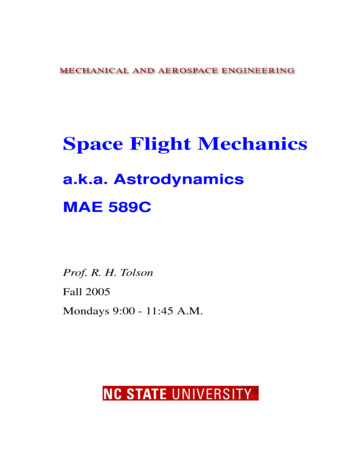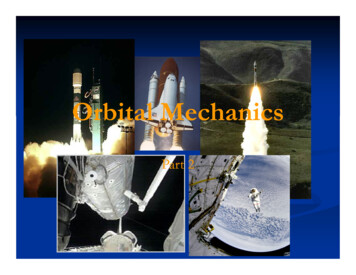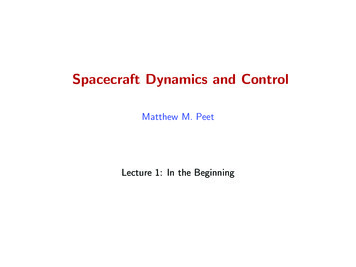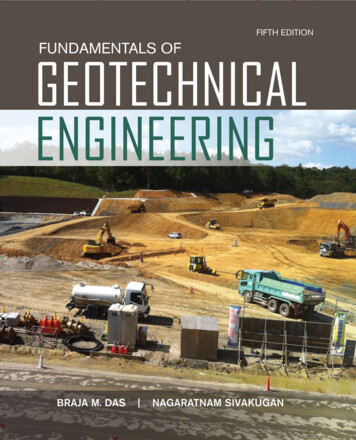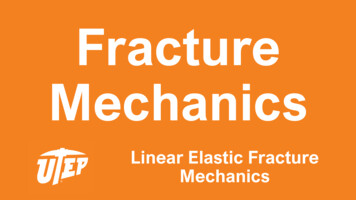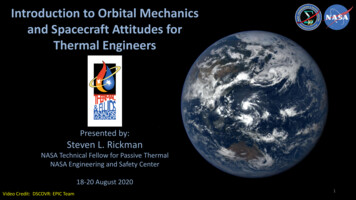
Transcription
Introduction to Orbital Mechanicsand Spacecraft Attitudes forThermal EngineersPresented by:Steven L. RickmanNASA Technical Fellow for Passive ThermalNASA Engineering and Safety Center18-20 August 2020Video Credit: DSCOVR: EPIC Team1
Differences in Lesson ScopeIntroduction to OrbitalMechanics andSpacecraft Attitudesfor Thermal Engineers 2-Body ProblemConservation of EnergyConservation ofMomentumKepler’s LawsSun Synchronous OrbitGeostationary OrbitMolniya OrbitAdvanced Orbit ConceptsReference FramesSpacecraft AttitudeTransformationsGeneral View FactorEquationIntroduction to OnOrbit ThermalEnvironments BetaAngle Eclipse Solar Flux SimpleViewFactor Albedo OLR2
References and CreditsReferences and image sources are cited on each slide.Unless otherwise credited, animations were developed by the authorusing Copernicus 4.6.Microsoft Clip Art was used in the presentation.3
DisclaimersThe equations and physical constants used in this lesson are forinstructional purposes only and may involve simplifications and/orapproximations and should not be used for design, analysis or missionplanning purposes.While screen shots or analyses resulting from analysis tools arepresented, no endorsement for any tool is made.4
IntroductionOrbiting spacecraft are subject to a variety of environments.Knowledge of the orbit is required to quantify the solar, albedo and planetary (also called outgoing longwaveradiation, or OLR) fluxes.Some specific questions that might arise are: How close (or how far) does the planet/spacecraft pass from the sun? How close (or how far) does a spacecraft pass from a planet and how does it affect orbital heating tospacecraft surfaces? How long does the spacecraft spend in eclipse during each orbit? At what angle does the solar flux impinge on the orbit plane (𝛽 angle) and how does that affect thethermal environment? What path does a spacecraft take between planets and how does the solar flux change during thattransfer? Why is one type of orbit used for some spacecraft and another type used for others (e.g., sunsynchronous versus geostationary)? What factors can make an orbit change over time and how might that affect the thermal environment? What type of thermal environment extremes will the spacecraft experience?5
IntroductionOrbit information alone is insufficient to determine how the environment affects the spacecraft.Spacecraft orientation (or “attitude”) and orbit information is required to determine which spacecraft surfacesexperience a given thermal environment.Spacecraft attitude and orbit information are required to determine the view factor to the central body which isrequired for planetary and albedo flux calculations to a spacecraft surface.What are the effects on the heating fluxes experienced by a spacecraft due to the attitude reference frame (e.g.,celestial inertial versus local vertical – local horizontal reference frames)?What spacecraft orientation(s) provide favorable thermal conditions for spacecraft components?Orbits and spacecraft attitudes must be considered together for a successful spacecraft and mission design.6
Scope of this LessonOrbitsSpacecraft attitudesGoverning differential equationConservation of specific mechanical energyConservation of specific angular momentumKepler’s lawsPerturbationsConsequences for the thermal environment.7
Lesson Contents (1 of 5)Part 1 -- Review of Scalar, Vector and Matrix OperationsScalars and VectorsCartesian CoordinatesVector Dot ProductVector Cross ProductUnit VectorsCoordinate TransformationsThe Euler Angle SequenceRotation SequencesForming the Transformation MatrixStacking the Transformations8
Lesson Contents (2 of 5)Part 2 -- The Two Body ProblemAside: Anatomy of an OrbitAside: HistoryStrategyNewton’s LawsRelative MotionAside: Some Useful Expansions of TermsConservation of Specific Mechanical EnergyConservation of Specific Angular MomentumKepler’s First LawCircular OrbitElliptical OrbitParabolic OrbitHyperbolic OrbitExample: Determining Solar Flux Using Kepler’s First LawKepler’s Second LawExample: Using Kepler’s Second Law to Determine How Solar Flux Varies with TimeKepler’s Third LawExample: Determine Planet Orbital Periods Using Kepler’s Third LawExample: Geostationary Orbit9
Lesson Contents (3 of 5)Part 3 -- Perturbed OrbitsGoverning Differential EquationPerturbationsPrecession of the Ascending NodeExample: Sun Synchronous OrbitPrecession of the PeriapsisExample: Molniya OrbitThe Effect of Orbit Perturbations on the Thermal EnvironmentThe Beta AngleCalculating the Beta AngleVariation of the Beta Angle Due to Seasonal Variation and Orbit PrecessionConsequences of Beta Angle VariationEclipseCalculating Umbral Eclipse Entry and Exit AnglesFraction of Orbit Spent in Sunlight/EclipseExample: Eclipse Season for a Geostationary OrbitExample: ISS OrbitExample: Sun Synchronous Orbit10
Lesson Contents (4 of 5)Part 4 -- Advanced Orbit ConceptsTransfer OrbitOrbit Plane ChangeAerobraking OrbitGravity AssistsThe Restricted Three-Body ProblemHalo OrbitsArtemis IGateway (Near Rectilinear Halo Orbit)11
Lesson Contents (5 of 5)Part 5 -- Spacecraft AttitudesReference FramesVehicle Body AxesLocal Vertical-Local Horizontal (LVLH)Celestial Inertial (CI)Comparing LVLH and CI Reference FramesAttitude Transformation StrategyTransforming Attitudes in CITransforming Attitudes from LVLH into CIAside: View Factor to Planet as a Function of Orbit and AttitudeExample: Heating to Spacecraft Surfaces as a Function of Orbit and AttitudeConclusionAcknowledgementsTo Contact the Author12
Part 1 -- Review of Scalar, Vector, and MatrixOperations13
Part 1 -- ContentPart 1 of this lesson is a review of mathematical operations we will need in our studyof orbital mechanics and spacecraft attitudes.We will begin with a review of scalars and vectors.After a brief review of Cartesian and Polar coordinates, we’ll consider vector dot andcross products, units vectors, coordinate transformations with particular focus on theEuler angle sequence, forming transformation matrices and, finally, stackingtransformations.14
Scalars and VectorsA scalar has a magnitude whereas a vector has, both, a magnitude and adirection.As an example, speed is a scalar and has a magnitude (e.g., 30 m/s) butvelocity is a vector and has a magnitude and direction (e.g., 30 m/s inthe 𝑥-direction).We will use, both, scalars and vectors in our study of orbital mechanicsand attitudes.15
Cartesian CoordinatesConsider the Cartesian coordinate system. 𝒌Each axis is orthogonal to the others.𝑥, 𝑦, 𝑧Any point in the coordinate system may bedescribed by three coordinates 𝑥, 𝑦, 𝑧 .𝑧𝒋Ƹ𝑥To aid in describing the amount of travel ineach orthogonal direction, we specify unit vectors (𝒊,Ƹ 𝒋,Ƹ 𝒌).𝑦𝒊Ƹ16
Polar CoordinatesPolar coordinates specifythe location of a point usingtwo coordinates, a distancefrom the origin, 𝑟 and anangle, 𝜃.90 𝑟𝜃0 180 Polar coordinates will beespecially useful in ourdiscussion of orbits.270 17
VectorsThe vector, 𝒓ത can be expressed in Cartesiancoordinates as: 𝒌 𝒓ത 𝑥 𝒊Ƹ 𝑦𝒋Ƹ 𝑧𝒌𝒓ത𝑥, 𝑦, 𝑧𝑧𝒋Ƹ𝑥The magnitude of the vector, 𝒓ത is given by:𝑦𝒊Ƹ𝒓ത 𝑥2 𝑦2 𝑧218
Useful Vector OperationsConsider the two vectors shown at theright 𝒓ത 𝑥𝑟 0 𝒊Ƹ 𝑦𝑟 0 𝒋Ƹ 𝑧𝑟 0 𝒌 𝑥𝑟 𝒊Ƹ 𝑦𝑟 𝒋Ƹ 𝑧𝑟 𝒌 𝒌𝑥𝑟 , 𝑦𝑟 , 𝑧𝑟𝑥𝑠 , 𝑦𝑠 , 𝑧𝑠𝒔തത𝒓𝜃𝒋Ƹ0,0,0 𝒔ത 𝑥𝑠 0 𝒊Ƹ 𝑦𝑠 0 𝒋Ƹ 𝑧𝑠 0 𝒌 𝑥𝑠 𝒊Ƹ 𝑦𝑠 𝒋Ƹ 𝑧𝑠 𝒌𝒊Ƹ19
Vector Dot ProductThe dot product of two vectors, 𝒓ത and 𝒔ത , isa scalar given by 𝒓ത 𝒔ത 𝒓ത 𝒔ത cos 𝜃 𝒌𝑥𝑟 , 𝑦𝑟 , 𝑧𝑟𝑥𝑠 , 𝑦𝑠 , 𝑧𝑠𝒔തFor the vectors shown at the right 𝒓ത 𝒔ത 𝑥𝑟 𝑥𝑠 𝑦𝑟 𝑦𝑠 𝑧𝑟 𝑧𝑠ത𝒓𝜃0,0,0𝒋Ƹ𝒊Ƹ20
Vector Cross ProductThe cross product of two vectors, 𝒓ത and 𝒔ത , is a vector given by 𝒌𝒊Ƹ𝒓ത 𝒔ത 𝑥𝑟𝑥𝑠𝒋Ƹ𝑦𝑟𝑦𝑠 𝒌𝑧𝑟𝑧𝑠For the vectors shown at the right 𝑥𝑟 , 𝑦𝑟 , 𝑧𝑟𝑥𝑠 , 𝑦𝑠 , 𝑧𝑠𝒔തത𝒓𝜃0,0,0𝒋Ƹ𝒊Ƹ 𝒓ത 𝒔ത 𝑦𝑟 𝑧𝑠 𝑧𝑟 𝑦𝑠 𝒊Ƹ 𝑥𝑟 𝑧𝑠 𝑧𝑟 𝑥𝑠 𝒋Ƹ 𝑥𝑟 𝑦𝑠 𝑦𝑟 𝑥𝑠 𝒌21
Unit VectorsAs the name implies, a unit vector is avector with one unit of length;𝑥𝑟 , 𝑦𝑟 , 𝑧𝑟 𝒌𝒓ොTo form a unit vector, 𝒓ො in the direction of𝒓ത 𝒓ത𝒓ො 𝒓ത𝑥𝑠 , 𝑦𝑠 , 𝑧𝑠𝒓ത𝑥𝑟 𝑥𝑠2 𝑦𝑟 𝑦𝑠𝒓ത𝒋Ƹ2 𝑧𝑟 𝑧𝑠2𝒊Ƹ22
Coordinate TransformationsAnalysis of spacecraft in orbit in a specified attitude requires anunderstanding of coordinate system transformations.The position in orbit and the position with respect to heating sourcesand the eclipse is determined using coordinate system transformations.Additional transformations are performed to orient the spacecraft asdesired at any given point in orbit.These transformations are performed as Euler angle sequences.23
The Euler Angle SequenceAn Euler angle sequence is a sequence of rotations of a rigid body withrespect to a fixed coordinate system.The sequence is order dependent – that is, changing the order of therotations will affect the resulting transformation.We will rely on Euler angle transformations considerably during thislesson.They are easily executed using multiplication of 3 3 matrices.Some info from: https://en.wikipedia.org/wiki/Euler angles24
Rotation SequencesHowever, we need to be specific about the type of rotation we seek –there are two possibilities:Rotation of the axes, orRotation of an object relative to fixed axes.We ultimately seek a rotation of an object relative to fixed axes.From: mathworld.wolfram.com/RotationMatrix.html25
Rotation Sequencesഥ which is at anConsider the vector 𝑷angle, 𝜙 from the 𝑥-axis in the fixedcoordinate system.𝑦ഥ ′ 𝑥 ′, 𝑦′𝑷𝑟We wish to transform this vector intoഥ ′ by rotating it through angle, 𝜃 in𝑷the same fixed coordinate system.What are the coordinates of the tip ofഥ ′ , that is 𝑥 ′ , 𝑦 ′ , in terms of 𝑥 and 𝑦?𝑷ഥ (𝑥, 𝑦)𝑷𝑟𝜃𝜙𝑥26
Rotation SequencesFrom the figure, we see 𝑦ഥ ′ 𝑥 ′, 𝑦′𝑷𝑥 𝑟 cos 𝜙𝑦 𝑟 sin 𝜙𝑟ഥ (𝑥, 𝑦)𝑷And 𝑟′𝑥 𝑟 cos 𝜙 𝜃𝑦 ′ 𝑟 sin 𝜙 𝜃𝜃𝜙From: https://www.youtube.com/watch?v NNWeu3dNFWA𝑥27
Rotation SequencesBut, using trigonometric identities, we see that 𝑥 ′ 𝑟 cos 𝜙 𝜃 𝑟 cos 𝜙 cos 𝜃 𝑟 sin 𝜙 sin 𝜃𝑦 ′ 𝑟 sin 𝜙 𝜃 𝑟 cos 𝜙 sin 𝜃 𝑟 sin 𝜙 cos 𝜃And since 𝑥 𝑟 cos 𝜙 and 𝑦 𝑟 sin 𝜙, we can substitute to obtain 𝑥 ′ 𝑟 cos 𝜙 𝜃 𝑥 cos 𝜃 𝑦 sin 𝜃𝑦 ′ 𝑟 sin 𝜙 𝜃 𝑥 sin 𝜃 𝑦 cos 𝜃Or, in matrix form 𝑥′cos 𝜃 𝑦′sin 𝜃From: https://www.youtube.com/watch?v NNWeu3dNFWA sin 𝜃 𝑥cos 𝜃 𝑦28
Forming the Transformation Matrixഥ in the 𝑥𝑦 plane about a vector coming out ofWe rotated the vector 𝑷the page.This is a 𝑧-axis transformation and any 𝑧 coordinate would remainunchanged. Hence, the 3 3 transformation matrix becomes 2 2cos 𝜃sin 𝜃 sin 𝜃cos 𝜃3 3cos 𝜃sin 𝜃0 sin 𝜃cos 𝜃000129
Forming the Transformation MatrixSimilar operations allow formation of rotation matrices about the 𝑥- and𝑦-axes. The resulting transformation matrices are 𝑥-axis:𝑥′1𝑦′ 00𝑧′𝑦-axis:𝑥′cos 𝜃𝑦′ 0 sin 𝜃𝑧′𝑧-axis:𝑥′cos 𝜃𝑦′ sin 𝜃0𝑧′𝑥0 sin 𝜃 𝑦cos 𝜃 𝑧0cos 𝜃sin 𝜃010sin 𝜃 𝑥𝑦0cos 𝜃 𝑧 sin 𝜃cos 𝜃00 𝑥0 𝑦1 𝑧30
Forming the Transformation MatrixWe will employ the following shorthand to represent transformation ofa vector, in this case 𝒓ത into 𝒓ത ′, about the 𝑥 , 𝑦 , and 𝑧 axes,respectively 𝒓ത ′ 𝑋 𝒓ത𝒓ത ′ 𝑌 𝒓ത𝒓ത ′ 𝑍 𝒓ത31
Stacking the TransformationsA series of rotations may be formed through multiplication of the 3 3transformation matrices in the order which they are to occur.For example, if we wish to transform 𝒓ത in to 𝒓ത ′ through an Euler anglerotation sequence first about the 𝑥 axis, then about the 𝑦 axis andfinally about the 𝑧 axis, the transformation is given by 𝒓ത ′ 𝑋 𝑌 𝑍 𝒓ത32
Part 1 Wrap UpIn Part 1, we established that many facets of orbital mechanics andspacecraft attitudes are of interest to thermal engineers;We reviewed key vector and matrix operations including Euler angletransformations that will serve as a tool kit for our study of orbitalmechanics and attitudes.33
Part 2 -- The Two Body Problem34
Aside: Anatomy of an OrbitPeriapsis -- the locationof minimum orbitaltitude𝑎Semimajor Axis-- halfthe distance fromapoapsis to periapsis𝜈True Anomaly -angle from theperiapsis locationto the spacecraftlocation,measured in theorbit planeApoapsis -- the locationof maximum orbitaltitude Focus FocusArgument of Periapsis -the angle, measured inthe orbit plane, fromthe ascending node tothe periapsisInclination -- the tilt ofthe orbit plane withrespect to the equator𝜔𝑖Ascending Node -- the locationwhere the orbit crosses theequator headed south to northRight Ascension of the Ascending Node willbe discussed in a subsequent sectionΩ𝑒Eccentricity describes the shape of the orbitand will be discussed in a subsequent section35
Aside: HistoryTycho Brahe was anoutstanding observationalastronomer and meticulouslyrecorded the positions of theplanets.Johannes Kepler used Brahe’sobservational data to fitgeometrical curves to explainthe position of Mars.Brahe, 1546-1601Image Credits: https://en.wikipedia.org/wiki/Johannes Kepler and https://en.wikipedia.org/wiki/Tycho BraheOther info from: Bate, R. R., Mueller, D. D., and White, J. E., Fundamentals of Astrodynamics, Dover Publications, New York, 1971.Kepler, 1571-163036
Aside: HistoryKepler formulated his three laws of planetarymotion:Kepler’s 1st Law: The orbit of each planet is an ellipse, withthe sun as a focus.Kepler’s 2nd Law: The line joining the planet to the sunsweeps out equal areas in equal times.Kepler’s 3rd Law: The square of the period of a planet isproportional to the cube of its mean distance to the sun.Image Credit: https://en.wikipedia.org/wiki/Johannes KeplerOther info from: Bate, R. R., Mueller, D. D., and White, J. E., Fundamentals of Astrodynamics, Dover Publications, New York, 1971.Kepler, 1571-163037
Aside: HistoryIn the context of orbital mechanics,Newton’s 2nd Law and his Law of UniversalGravitation are pertinent:Newton’s 2nd Law: The sum of the forces is equalto mass times acceleration.Gravitation: Every particle attracts every otherparticle in the universe with a force which isdirectly proportional to the product of theirmasses and inversely proportional to the square ofthe distance between their centers.Image Credit: https://en.wikipedia.org/wiki/Isaac NewtonSource: https://en.wikipedia.org/wiki/Newton%27s law of universal gravitationNewton, 1643 (1642 O.S.) - 172738
StrategyWe will derive the governing differential equation for two body motion foran unperturbed orbit.We will also show that specific mechanical energy and specific angularmomentum are conserved for the unperturbed orbit.From this, we will derive Kepler’s Laws and apply them in examples.39
Newton’s LawsThe governing differential equation for two body astrodynamics is derivedfrom two laws originated by Sir Isaac Newton.Newton’s 2nd Lawഥ 𝑚ഥ𝑭𝒂Newton’s Law of Gravitation 𝐺𝑀𝑚 𝒓തഥ 𝑭𝑟2𝑟40
Relative MotionWe will need to define a reference frame for thecalculations. Consider the coordinate systems with masses𝑀 and 𝑚 at the right where 𝒁𝒁′𝑀 is the mass of the first body (assumed to be the largermass)𝑚 is the mass of the smaller body (assumed here 𝑚 𝑀)𝒓ത 𝑴 is the vector from the origin of the referencecoordinate system to the center of M𝒓ത 𝒎 is the vector from the origin of the reference𝑿′coordinate system to the center of m𝒓ത is the vector between 𝑀 and 𝑚𝒓ത 𝑴𝒀𝒓ത𝑚𝑀𝑿𝒓ത 𝒎𝒀′𝑋’𝑌’𝑍’ is inertial and 𝑋𝑌𝑍 is non-rotating.From: Bate, R. R., Mueller, D. D., and White, J. E., Fundamentals of Astrodynamics, Dover Publications, New York, 1971.41
Relative MotionWe see that:𝒓ത 𝒓ത 𝑚 𝒓ത 𝑀𝒁𝒁′Recognize that since 𝑋𝑌𝑍 is non-rotatingwith respect to 𝑋’𝑌’𝑍’, the respectivemagnitudes of 𝒓ത and 𝒓തሷ , will be equal inboth systems.𝒓ത 𝒓ത 𝑚 𝒓ത 𝑀 𝒓തሷ 𝒓തሷ 𝑚 𝒓തሷ 𝑀𝒓ത 𝑴𝒀𝒓ത𝑚𝑀𝑿𝒓ത 𝒎𝒀′𝑿′From: Bate, R. R., Mueller, D. D., and White, J. E., Fundamentals of Astrodynamics, Dover Publications, New York, 1971.42
Relative MotionApplying Newton’s laws, we have:𝐺𝑀𝑚 𝒓ത𝑚𝒓തሷ 𝒎 2𝑟𝑟𝒁𝒁′𝒓ത 𝑴𝐺𝑀𝑚 𝒓ത𝑀𝒓തሷ 𝑴 2𝑟𝑟𝒀𝒓ത𝑚𝑀𝑿𝒓ത 𝒎𝒀′𝑿′From: Bate, R. R., Mueller, D. D., and White, J. E., Fundamentals of Astrodynamics, Dover Publications, New York, 1971.43
Relative MotionCombining the two previous expressions,we arrive at:𝒁𝐺 𝑀 𝑚𝒓തሷ 𝒓ത3𝑟𝒁′𝒓ത 𝑴𝒀𝒓ത𝑚𝑀𝑿𝒓ത 𝒎𝒀′𝑿′From: Bate, R. R., Mueller, D. D., and White, J. E., Fundamentals of Astrodynamics, Dover Publications, New York, 1971.44
Relative MotionFor a spacecraft orbiting a planet or the sun (or even planets or otherbodies orbiting the sun), 𝑀 𝑚 so the expression becomes:μ𝒓തሷ 3 𝒓ത 𝟎𝑟Where 𝜇 𝐺𝑀, 𝑀 is the mass of the central body (i.e., the body beingorbited) and 𝐺 6.67 10 11 𝑁𝑚2 𝑘𝑔 2 .From: Bate, R. R., Mueller, D. D., and White, J. E., Fundamentals of Astrodynamics, Dover Publications, New York, 1971.45
Aside: Some Useful Expansions of TermsFor an orbit, we have:𝒓ത 𝑟ො𝒓𝑑𝑟𝑑𝜃 ഥ 𝒓തሶ 𝒗𝒓ො 𝑟𝜽𝑑𝑡𝑑𝑡𝑑2 𝑟𝑑𝜃ഥ 𝒗ഥሶ 𝒓തሷ 𝒂 𝑟2𝑑𝑡𝑑𝑡21 𝑑 2 𝑑𝜃𝒓ො 𝑟𝑟 𝑑𝑡𝑑𝑡 𝜽From: Battin, R. H., An Introduction to the Mathematics and Methods of Astrodynamics, New York, American Institute of Aeronautics and Astronautics, 1987.46
Conservation of Specific Mechanical EnergyTo show conservation of specific mechanical energy, form the dot product ofthe governing differential equation with 𝒓തሶ :μ𝒓തሶ 𝒓തሷ 3 𝒓ത 𝒓തሶ 𝟎𝑟μ𝒓തሶ 𝒓തሷ 𝒓തሶ 3 𝒓ത 𝟎𝑟47
Conservation of Specific Mechanical EnergyRearranging μ𝒓തሶ 𝒓തሷ 3 𝒓തሶ 𝒓ത 𝟎𝑟We note that 𝑑1𝑑ഥ 𝒗ഥ2 𝒓തሶ 𝒓തሷ 𝒓തሶ 𝒓തሶ 𝒓തሶ 𝒓തሷ 𝒗𝑑𝑡2 𝑑𝑡𝑑𝑑𝑟2 𝒓തሶ 𝒓ത 𝒓ത 𝒓ത 2𝑟𝑑𝑡𝑑𝑡48
Conservation of Specific Mechanical EnergySubstituting 1𝑑μ1𝑑ഥ 𝒗ഥ 3𝒗𝒓ത 𝒓ത 𝟎2 𝑑𝑡𝑟 2 𝑑𝑡Which becomes 1 𝑑 𝑣2μ 1 𝑑 𝑟2 3 𝟎2 𝑑𝑡𝑟 2 𝑑𝑡49
Conservation of Specific Mechanical EnergyThis becomes 1 𝑑 𝑣2μ 𝑑𝑟 3𝑟 𝟎2 𝑑𝑡𝑟 𝑑𝑡Rearranging and simplifying 𝑑 𝑣2𝜇 𝑑𝑟 2 𝟎𝑑𝑡 2𝑟 𝑑𝑡50
Conservation of Specific Mechanical EnergyIntegrating with respect to time 𝑣2 𝜇 𝑐𝑜𝑛𝑠𝑡𝑎𝑛𝑡2 𝑟The first term is recognized as the kinetic energy per unit mass and thesecond term is gravitational potential energy per unit mass. The quantity isconstant and the specific mechanical energy is conserved.Adapted from: Bate, R. R., Mueller, D. D., and White, J. E., Fundamentals of Astrodynamics, Dover Publications, New York, 1971 -and-space-geometry.html51
Conservation of Specific Angular MomentumConservation of specific angular momentum (i.e., momentum per unit mass)may be shown taking the cross product of 𝒓ത and the governing differentialequation μ𝒓ത 𝒓തሷ 𝒓ത 3 𝒓ത 𝟎𝑟We note that a vector crossed with itself it is 𝟎. The equation simplifies to 𝒓ത 𝒓തሷ 𝟎From: Bate, R. R., Mueller, D. D., and White, J. E., Fundamentals of Astrodynamics, Dover Publications, New York, 1971.52
Conservation of Specific Angular MomentumWe also note that 𝑑𝒓ത 𝒓തሶ 𝒓തሶ 𝒓തሶ 𝒓ത 𝒓തሷ𝑑𝑡We note 𝒓തሶ 𝒓തሶ 𝟎. The equation simplifies to 𝑑𝒓ത 𝒓തሶ 𝒓ത 𝒓തሷ 𝟎𝑑𝑡From: Bate, R. R., Mueller, D. D., and White, J. E., Fundamentals of Astrodynamics, Dover Publications, New York, 1971.53
Conservation of Specific Angular Momentumഥ so the equation becomes Finally, we recognize that 𝒓തሶ 𝒗𝑑ഥ 𝟎𝒓ത 𝒗𝑑𝑡ഥ 𝒓ത 𝒗ഥ is recognized as the specific angular momentum and wewhere 𝒉have shown that this does not change with time ഥ 𝒓ത 𝒗ഥ 𝒄𝒐𝒏𝒔𝒕𝒂𝒏𝒕𝒉From: Bate, R. R., Mueller, D. D., and White, J. E., Fundamentals of Astrodynamics, Dover Publications, New York, 1971.54
Derivation of Kepler’s LawsNow that we have the governing differential equation, the conservation of,both, specific mechanical energy and specific angular momentum, we areready to derive Kepler’s laws.55
Kepler’s First LawThe orbit of eachplanet is an ellipse*,with the sun as afocus.*Actually, other orbitshapes are possibleand are described bythe “conic sections.”Orbits of the Inner Planets56
Kepler’s First LawBut what is a “conicsection”?Take a cone and cut it with aplane at different anglesThe shapes appearing at thecutting plane are also theshapes of the orbits.57
Kepler’s First LawStarting with the governing differential equation:Re-arrange to get:μ𝒓തሷ 3 𝒓ത 𝟎𝑟μ𝒓തሷ 3 𝒓ത𝑟Form the cross product with the angular momentum vector:μμഥ ഥ ഥ 𝒓തത𝒓തሷ 𝒉𝒓 𝒉𝒉33𝑟𝑟From: Bate, R. R., Mueller, D. D., and White, J. E., Fundamentals of Astrodynamics, Dover Publications, New York, 1971.58
Kepler’s First LawLet’s examine this equation in more detail:ഥ 𝒓തሷ 𝒉μഥ 𝒓ത𝒉𝑟3We see that:0𝑑ሶഥഥഥഥ𝒓തሷ 𝒉 𝒓തሷ 𝒉 𝒓തሶ 𝒉 𝒓തሶ 𝒉𝑑𝑡μμμഥ 𝒓ത ഥ 𝒓ത 3 𝒗ഥ 𝒓ത 𝒓ത 𝒓ത 𝒓ത 𝒗ഥ𝒉𝒓ത 𝒗33𝑟𝑟𝑟From: Bate, R. R., Mueller, D. D., and White, J. E., Fundamentals of Astrodynamics, Dover Publications, New York, 1971.59
Kepler’s First Lawഥ 𝒓ത :And, within the triple vector product 𝒓ത 𝒗ഥ 𝒓ത 𝒗ഥ 𝒓ത 𝒓ത 𝒓ത 𝒓ത 𝒗ഥ𝒓ത 𝒗We note that:𝑑𝑟𝑑𝜃 𝑟𝑟ሶഥ 𝒓ത 𝒓തሶ 𝑟ො𝒓 𝒓ത 𝒗𝒓ො 𝑟𝜽𝑑𝑡𝑑𝑡We end up with:μ𝜇𝜇𝑟ሶഥ 𝒓ത 𝒗ഥ 2 𝒓ത𝒉3𝑟𝑟𝑟From: https://en.wikipedia.org/wiki/Vector algebra relationsFrom: Bate, R. R., Mueller, D. D., and White, J. E., Fundamentals of Astrodynamics, Dover Publications, New York, 1971.60
Kepler’s First LawFurther simplification yields:𝜇𝜇𝑟ሶ𝑑 𝒓തഥ 2 𝒓ത 𝜇𝒗𝑟𝑟𝑑𝑡 𝑟Our equation becomes:𝑑𝑑 𝒓തഥ 𝜇𝒓തሶ 𝒉𝑑𝑡𝑑𝑡 𝑟From: Bate, R. R., Mueller, D. D., and White, J. E., Fundamentals of Astrodynamics, Dover Publications, New York, 1971.61
Kepler’s First LawRepeating for convenience:𝑑𝑑 𝒓തഥ 𝜇𝒓തሶ 𝒉𝑑𝑡𝑑𝑡 𝑟Integrating the above equation:𝒓തഥ 𝜇ഥ𝒓തሶ 𝒉 𝑩𝑟ഥ is a vector constant.Where 𝑩From: Bate, R. R., Mueller, D. D., and White, J. E., Fundamentals of Astrodynamics, Dover Publications, New York, 1971.62
Kepler’s First LawDot both sides of the equation with 𝒓ത :𝒓തഥ 𝒓ത 𝜇ഥ𝒓ത 𝒓തሶ 𝒉 𝒓ത 𝑩𝑟And since:ഥ 𝒓ത 𝒓തሶ 𝒉ഥ 𝒓ത 𝒗ഥ ℎ2ഥ 𝒉𝒓ത 𝒓തሶ 𝒉𝒓ത𝒓ത 𝜇 𝒓ത 𝜇ො𝒓 𝑟ො𝒓 𝜇ො𝒓 𝜇𝑟𝑟ഥ 𝑟𝐵 cos 𝜈𝒓ത 𝑩From: Bate, R. R., Mueller, D. D., and White, J. E., Fundamentals of Astrodynamics, Dover Publications, New York, 1971.63
Kepler’s First LawThe equation simplifies to:ℎ2 𝜇𝑟 𝑟𝐵 cos 𝜈Rearranging gives:ℎ2ൗ𝜇𝑟 1 𝐵ൗ𝜇 cos 𝜈From: Bate, R. R., Mueller, D. D., and White, J. E., Fundamentals of Astrodynamics, Dover Publications, New York, 1971.64
Kepler’s First LawWe see that the equation is in the same form as the general equation for aconic section in polar coordinates:ℎ2ൗ𝜇𝑟 1 𝐵ൗ𝜇 cos 𝜈𝑝𝑎 1 𝑒2𝑟 1 𝑒 cos 𝜈 1 𝑒 cos 𝜈The parameter, 𝑎, is the semimajor axis and 𝑒 is the orbit eccentricity.From: Bate, R. R., Mueller, D. D., and White, J. E., Fundamentals of Astrodynamics, Dover Publications, New York, 1971.65
Kepler’s First LawThe form of the equation confirms that an orbit derived under theseassumptions takes the shape of a conic section and its shape is dependentupon the orbit eccentricity, 𝑒:Eccentricity𝑒 00 𝑒 1Orbit ShapeCircleEllipse𝑒 1𝑒 1ParabolaHyperbolaLet’s take a look at some orbits representing each orbit type.From: Bate, R. R., Mueller, D. D., and White, J. E., Fundamentals of Astrodynamics, Dover Publications, New York, 1971.66
Circular OrbitCircular orbits maintain aconstant distance fromtheir central body.Orbit eccentricity, 𝑒 0.Many Earth satellites havecircular orbits.The International SpaceStation is in a circular orbit.Example: International Space Station Orbit67
Elliptical OrbitOrbit eccentricity, 0 𝑒 1.An elliptical orbit traces out anellipse with the central body atone focus.Comets such as 103P/Hartley 2are in elliptical orbits with aperiod of 6.46 years (𝑒 0.694).Example: Comet Hartley 2 OrbitImage Credit: NASA/Steele Hill; Inset Image Credit: NASA/JPL-Caltech/UMD68
Parabolic OrbitWhen orbit eccentricity, 𝑒 1,we have a parabolic orbit.“Within observationaluncertainty, long term comets allseem to have parabolic orbits.That suggests they are not trulyinterstellar, but are looselyattached to the Sun. They aregenerally classified as belongingthe Oort cloud on the fringes ofthe solar system, at distancesestimated at 100,000 AU.”Source: mImage Credit: oud/The Oort Cloud69
Hyperbolic OrbitOrbit eccentricity, 𝑒 1;For objects passing throughthe solar system, ahyperbolic orbit suggestsan interstellar origin -Asteroid Oumuamua wasdiscovered in 2017 and isfirst known object of thistype 𝑒 1.19951 .Video Credit: meteors/comets/oumuamua/in-depth/Source: e: Asteroid Oumuamua70
Example: Determining Solar Flux UsingKepler’s First LawWe saw that the equation is in the same form as the general equation for aconic section in polar coordinates:𝑝𝑎 1 𝑒2𝑟 1 𝑒 cos 𝜈 1 𝑒 cos 𝜈where 𝑎 and 𝑒 are constants and 𝜈 is the true anomaly. For a planet orbitingthe sun, 𝑟 is a minimum (a.k.a, perihelion) when 𝜈 0 and 𝑟 is maximum(a.k.a., aphelion) when 𝜈 180 .71
Example: Determining Solar Flux UsingKepler’s First LawAt Earth’s mean distance from the sun (i.e., 1 𝑎𝑢), the measured solar flux ison the order of 1371 𝑊 Τ𝑚2 .We can determine the solar flux at any distance, 𝑟 (measured in 𝑎𝑢) fromthe sun by noting:𝑞ሶ 𝑠𝑜𝑙𝑎𝑟1371 𝑊 Τ𝑚2𝑟 𝑟272
Example: Determining Solar Flux UsingKepler’s First LawSolar flux values for the planets are readily calculated:PlanetSemimajorAxis, 𝑎 (𝑎𝑢)Orbit Eccentricity,𝑒PerihelionDistance (𝑎𝑢)AphelionDistance (𝑎𝑢)Solar Flux atPerihelion𝑾Τ𝒎𝟐Solar Flux 8671.551.48Semimajor axis and eccentricity data from: nssdc.gsfc.nasa.gov73
Kepler’s Second LawThe line joining theplanet to the sunsweeps out equalareas, 𝐴 in equaltimes, 𝑡. 𝑡1 𝑡2𝐴1 𝐴2𝑨𝟏 𝒕𝟏𝑨𝟐 𝒕𝟐Demonstration of Constant “Areal” Velocity74
Kepler’s Second LawWe begin with our previously derived expression for the angular momentumഥvector, 𝒉:ഥ 𝒓ത 𝒗ഥ𝒉ഥ:And recalling the expressions for vectors 𝒓ത and 𝒗𝒓ത 𝑟ො𝒓𝑑𝑟𝑑𝜃 ഥ 𝒗𝒓ො 𝑟𝜽𝑑𝑡𝑑𝑡75
Kepler’s Second Lawഥ is, then:The expression for 𝒉𝒓ොഥ 𝒓ത 𝒗ഥ 𝑟𝒉𝑑𝑟𝑑𝑡 𝜽0𝑑𝜃𝑟𝑑𝑡 𝒌0 𝑟 2 𝑑𝜃 𝒌 𝑑𝑡0The magnitude of this vector is:ഥ ℎ 𝒉𝑟2𝑑𝜃𝑑𝑡76
Kepler’s Second LawWe showed previously that the specificangular momentum is constant ℎ 𝑟2𝑑𝜃 𝑐𝑜𝑛𝑠𝑡𝑎𝑛𝑡𝑑𝑡We also recognize that the area swept outover time is simply one half of the specificangular momentum 𝑟𝑑𝜃𝜃𝑟𝑑𝐴 11 2 𝑑𝜃 ℎ 𝑟 𝑐𝑜𝑛𝑠𝑡𝑎𝑛𝑡𝑑𝑡 22 𝑑𝑡77
Kepler’s Second LawConsider another approach 1𝑑𝐴 𝑟 𝑑𝑟 sin 𝛼2If we let the differential area, 𝑑𝐴 berepresented as a vector, 𝒅𝑨 𝑑𝐴𝛼𝒅𝒓𝒓ത1𝒅𝑨 𝒓ത 𝒅𝒓2From: ofs.pdf78
Kepler’s Second LawDifferentiate with respect to time 𝒅𝑨 1ሶ𝑨ഥ 𝒓ത 𝒓തሶ𝒅𝒕 2Differentiate again ഥሷ 𝑨Soሶ𝒅𝑨𝒅𝒕𝒅𝑨𝒅𝒕 1𝒓ത2 𝒓തሶ 120Vectorcrossedwith itselfVectors pointedin � 𝒓തሶ 𝒓ത 𝒓തሷ 0 𝒄𝒐𝒏𝒔𝒕𝒂𝒏𝒕From: ofs.pdf79
Example: Using Kepler’s Second Law toDetermine How Solar Flux Varies with TimeWe saw that knowing the shape of a planet’s orbit (aphelion and periheliondistances) and the solar flux at 1 𝑎𝑢 could be used to determine theminimum and maximum solar flux.In this example, we’ll calculate how the solar flux for Earth varies with timethroughout the year.In doing so, we’ll compare a simplified model with a more accuraterepresentation accounting for Kepler’s Second Law.80
Example: Using Kepler’s Second Law toDetermine How Solar Flux Varies with TimeA consequence of Kepler’s Second Law is that to sweep out equal areas inequal times, a planet (or moon or spacecraft) orbiting a central body (i.e.,the sun, a planet, moon, etc.) must move through its orbit faster at somelocations and slower at others.In other words, the angular rate at which the orbiting body moves aroundits orbit of the central body changes depending on where it is in its orbit.81
Example: Using Kepler’s Second Law toDetermine How Solar Flux Varies with TimeConsider Earth’s orbit around the sun. We know Earth makes one circuit ofthe sun in 365.25 days.If Earth’s orbit about the sun were circular, the angular rate would be:360 𝜈ሶ 0.986 Τ𝑑𝑎𝑦365.25 𝑑𝑎𝑦𝑠82
Example: Using Kepler’s Second Law toDetermine How Solar Flux Varies with TimeBut, Earth’s orbit about the sun isn’t circular, it is slightly elliptical with an𝑒 0.0167.This elliptical shape is what gives rise to the aphelion and periheliondistances and, hence, the variation in solar flux.But because of Kepler’s Second Law, the angular rate will vary dependingon Earth’s distance from the sun.83
Example: Using Kepler’s Second Law toDetermine How Solar Flux Varies with TimeSuch an approximation willnot work as well for planetswith more eccentric orbits.Comparison of Earth’s Solar Flux versus Date Based on Meanand True ProgressionSolar Flux at Earth’s Distance from the Sun(W/m2)We see that the assuming themean motion for Earth’s orbit(𝑒 0.0167) about the sunis a reasonable approximationto the slightly elliptical orbit.This due to the very loweccentricity of Earth’s 13207/1/20Solar Flux Based on TrueProgression of Earth's Orbit(W/m2)Solar Flux Based on MeanProgression of Earth's Orbit(W/m2)10/9/201/17/21Date4/27/218/5/2184
Example: Using Kepler’s Second Law toDetermine How Solar Flux Varies with TimeThe time variation of flux ismore pronounced due to theeffect of Kepler’s SecondLaw.Comparison of Mars’ Solar Flux versus Date Based on Meanand True ProgressionSolar Flux at Earth’s Distance from the Sun(W/m2)Consider Mars with aneccentricity, 𝑒 0.09339.750Solar Flux Based onTrue Progression ofMars' Orbit (W/m2)700650Solar Flux Based onMean Progression ofMars' Orbit (W/m2)6005505004500100200300400500Time Since Perihelion (days)60070085
Kepler’s Third LawThe square of the period, 𝑇 of aplanet is proportional to thecube of its mean distance, 𝑎 tothe sun (or its central body).Τ 2 𝑎3𝑎2𝑎For the orbits at the right:Τ𝑜𝑢𝑡𝑒𝑟 𝑜𝑟𝑏𝑖𝑡 23 Τ𝑖𝑛𝑛𝑒𝑟 𝑜𝑟𝑏𝑖𝑡Orbits with Different Semimajor Axes86
of orbital mechanics and spacecraft attitudes. We will begin with a review of scalars and vectors. After a brief review of artesian and Polar coordinates, we’ll consider vector dot and cross products, units vectors, coordinate transformations with particular focus on the Euler angle sequenc


